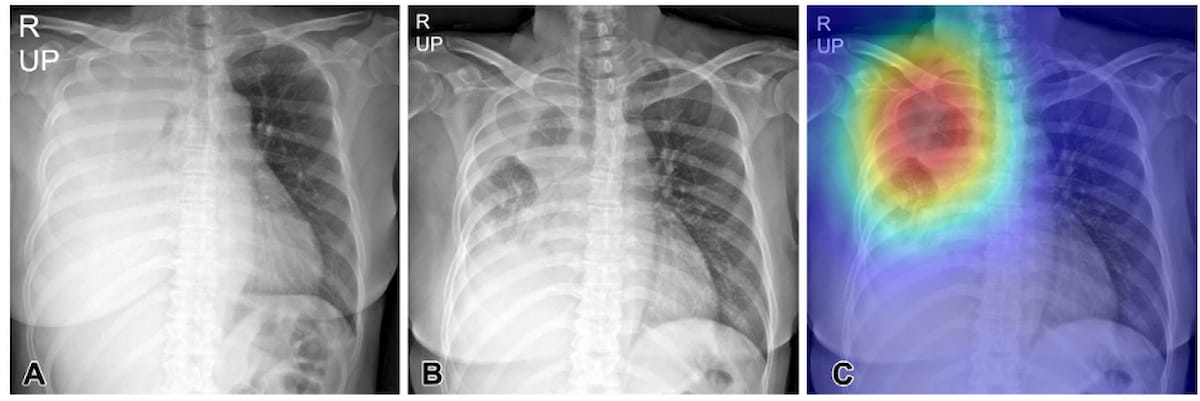Can AI Improve Triage Efficiency in Radiology Workflows for Follow-Up X-Rays?
An emerging deep learning algorithm can reportedly triage 40 percent of no-change X-rays while providing 88 to 90 percent accuracy for detecting changes with X-rays obtained in the emergency department and intensive care unit at a tertiary referral hospital, according to recently published research.
New research suggests an emerging deep learning algorithm, developed from over 3,300,000 chest X-rays, may facilitate significant triage of no-change X-rays, and offers specificity rates ranging between 78.6 and 93.9 percent for urgent X-ray findings in emergency department and intensive care unit (ICU) settings.
For the retrospective study, recently published in Radiology, researchers examined the effectiveness of a deep learning algorithm for reviewing pairs of baseline and follow-up X-rays obtained in the emergency department and ICU of a tertiary referral hospital. The algorithm was trained on 550,779 pairs of radiographs and validated with 1,620 pairs of X-rays evenly divided between no-change X-rays and change X-rays, according to the study.
In a test set of 533 pairs of X-rays obtained in the emergency department, researchers found that the deep learning algorithm had an 80 percent area under the receiver operating characteristic curve (AUC), an 88.4 percent specificity rate with a 40 percent triage threshold and a 79.9 percent specificity rate at a 60 percent triage threshold.
In a test set of 600 pairs of X-rays from the ICU, the study authors said the algorithm had an 80 percent AUC, a 90 percent specificity rate with a 40 percent triage threshold and a 79.3 percent specificity rate at a 60 percent triage threshold.
“A deep learning algorithm using thoracic cage registration and subtraction could provide automated triage of pairs of chest radiographs showing no change while detecting urgent interval changes. The 40% triage threshold, which achieved approximately 90% specificity, and the 60% triage threshold, which achieved approximately 80% specificity, could be used to reduce the workload in a setting where image pairs with no change comprise the majority and the change is not critical,” wrote lead study author Jihye Yun, Ph.D., who is affiliated with the Department of Radiology and Research Institute of Radiology at the Ulsan College of Medicine in Seoul, Korea, and colleagues.
In a gradient-weighted class activation map (C), use of a deep learning algorithm emphasizes key changes (an aerated lung) between the baseline chest X-ray (A) in the emergency department and an X-ray taken two days later (B). (Images courtesy of Radiology.)

(Editor’s note: For related content, see “Transformer-Based Multimodal AI Model Improves Diagnosis of Over 20 Conditions with Chest X-Rays,” “Study Raises Doubt About AI Sensitivity for Smaller and Multiple Findings on Chest X-Rays” and “Autonomous AI Shows Nearly 27 Percent Higher Sensitivity than Radiology Reports for Abnormal Chest X-Rays.”)
At a 40 percent triage threshold, researchers noted the deep learning algorithm had specificity rates for urgent X-ray findings ranging between 78.6 to 100 percent in the emergency department and between 85.5 and 93.9 percent for the ICU. Specifically, the study authors found specificity rates of 85.7 percent for pneumothorax and 100 percent for pleural effusion at a 40 percent triage threshold in the emergency department.
“Our findings suggest that most relevant changes could be accurately detected, despite the confounding effect of frequent alteration of patient posture and accompanying devices,” added Yun and colleagues.
Beyond the inherent limitations of a single-center retrospective study, the study authors conceded that the deep learning algorithm lacks adequate functionality for comparing images taken from non-identical positions, doesn’t recognize the removal of tubes or lines on X-rays, and can only be utilized with pairs of X-rays as opposed to a series of chest X-rays.
Could AI-Powered Abbreviated MRI Reinvent Detection for Structural Abnormalities of the Knee?
April 24th 2025Employing deep learning image reconstruction, parallel imaging and multi-slice acceleration in a sub-five-minute 3T knee MRI, researchers noted 100 percent sensitivity and 99 percent specificity for anterior cruciate ligament (ACL) tears.
Meta-Analysis Shows Merits of AI with CTA Detection of Coronary Artery Stenosis and Calcified Plaque
April 16th 2025Artificial intelligence demonstrated higher AUC, sensitivity, and specificity than radiologists for detecting coronary artery stenosis > 50 percent on computed tomography angiography (CTA), according to a new 17-study meta-analysis.